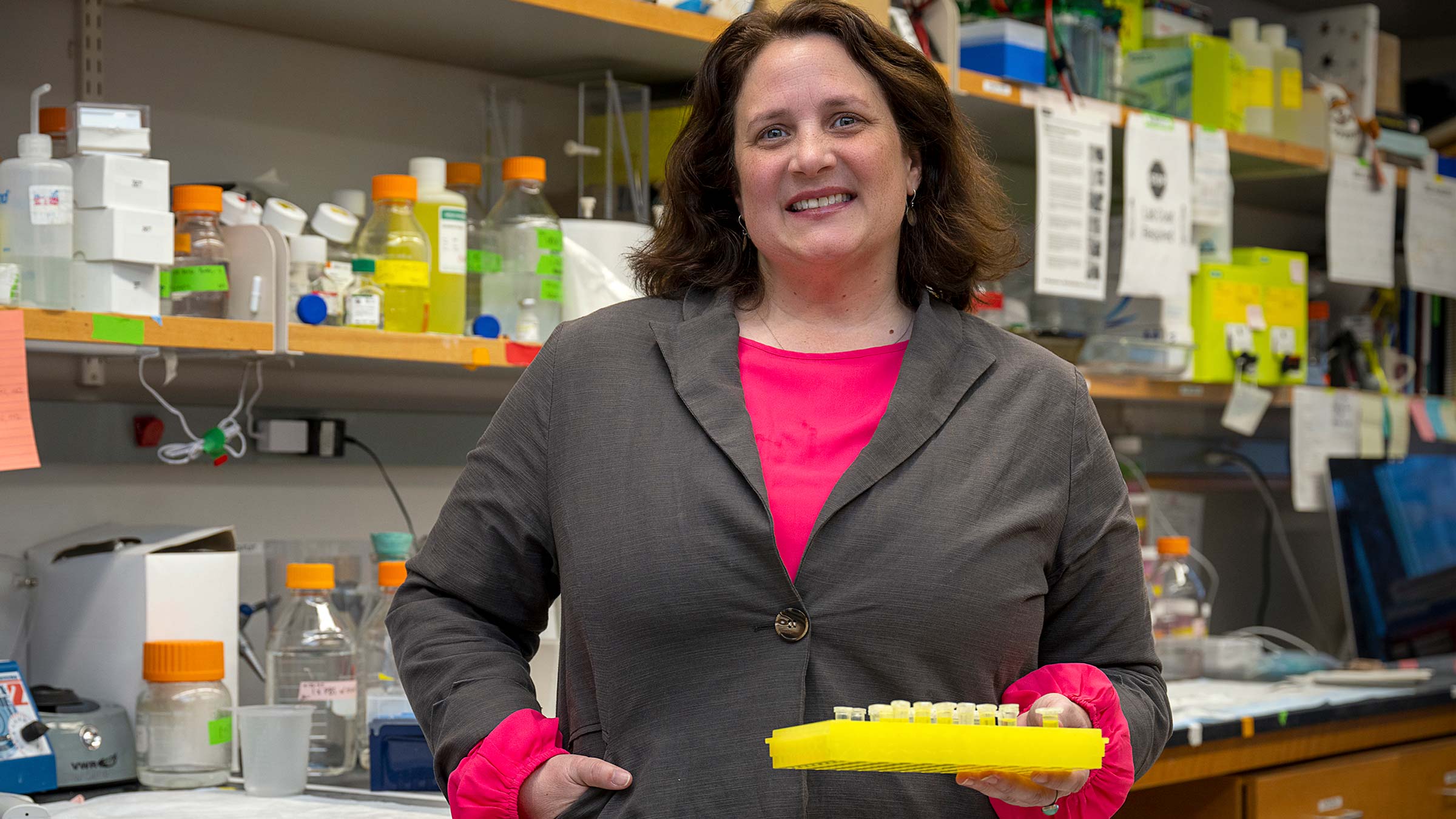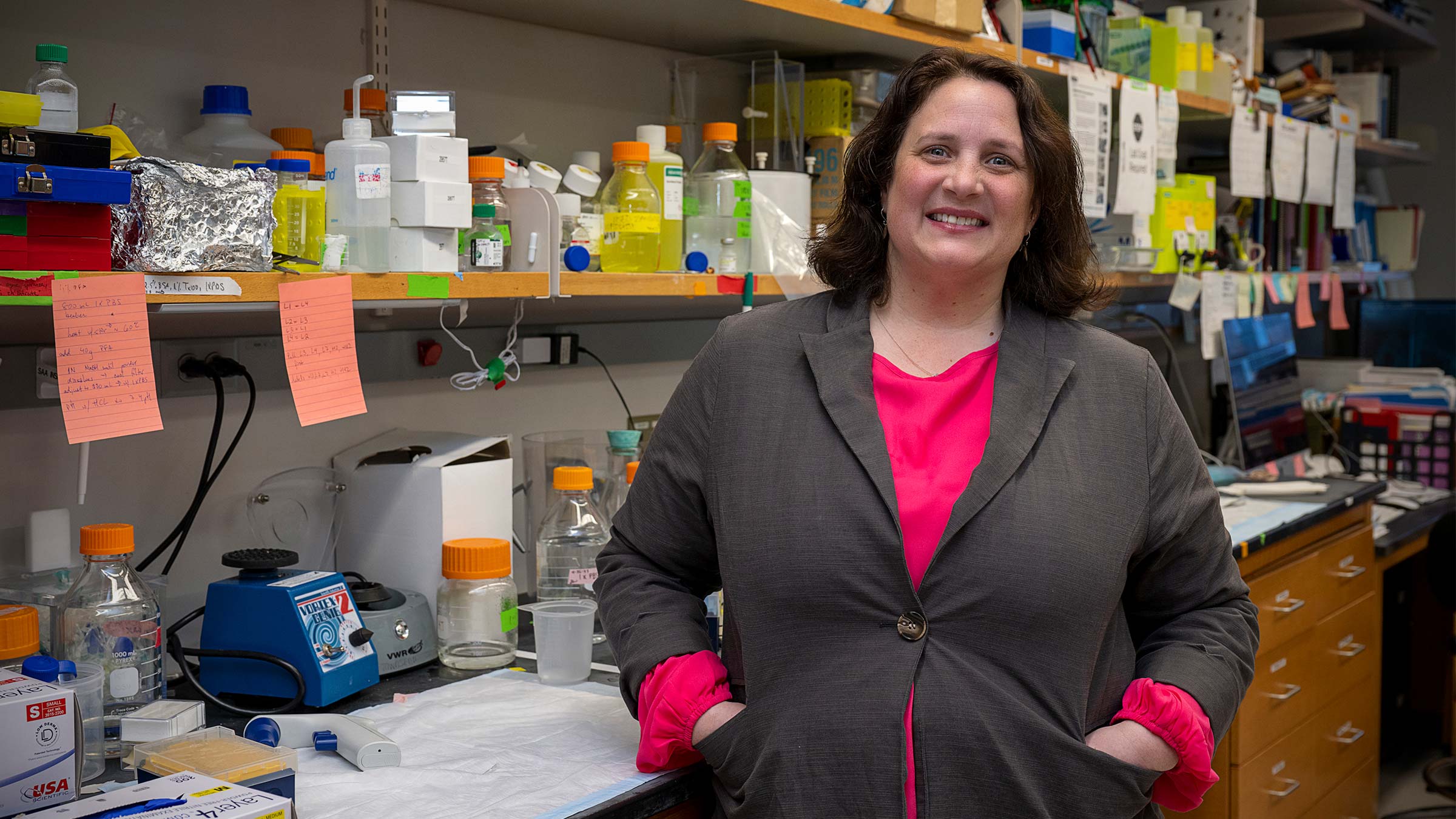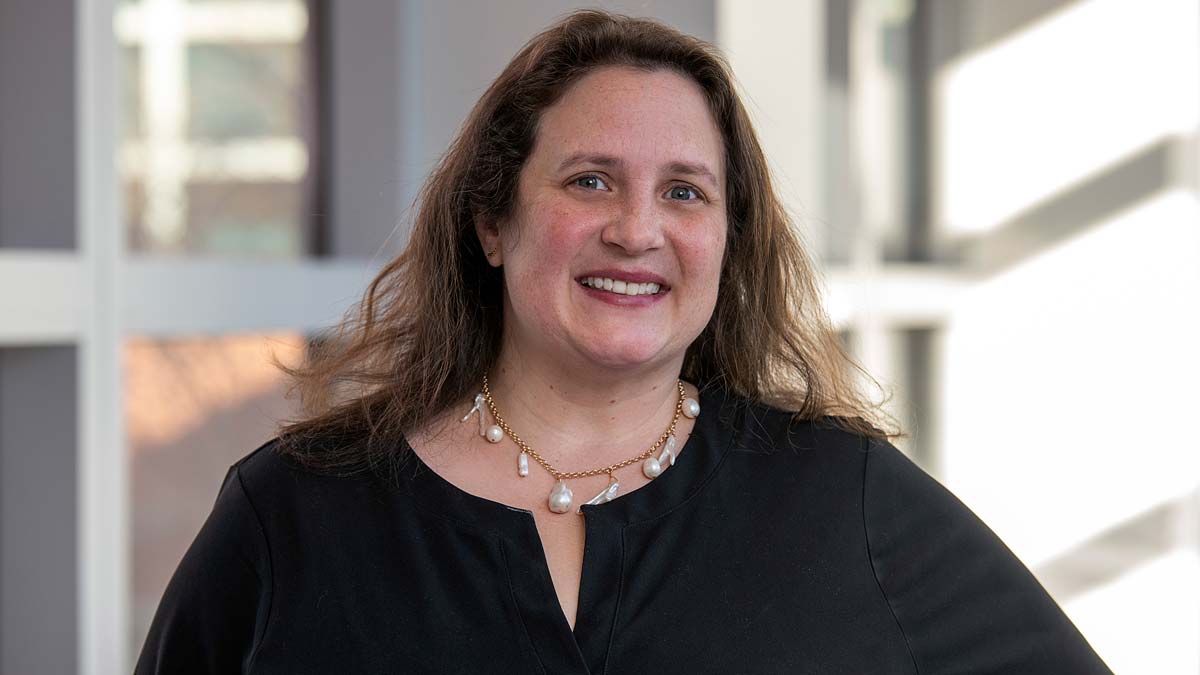Studying the nervous system to solve overlooked mysteries of women’s health
An Ohio State researcher is tackling disparities in research while creating breakthroughs in our understanding of how nerves and metabolism work together.
There’s a condition affecting obese women that rarely, if ever, affects obese men. Idiopathic intracranial hypertension (IIH) causes extreme pressure in the brain that can lead to vision loss and cognitive issues if left untreated. Kristy Townsend, PhD, had just moved her research lab and six members of her team from the University of Maine to The Ohio State University Wexner Medical Center when she heard about the condition over dinner with her new colleagues.
Her ears perked up.
As an expert in neuroscience and metabolism, Dr. Townsend talked about the condition with John McGregor, MD, clinical associate professor of Neurological Surgery. Dr. Townsend had come to Ohio State for the opportunity to do more research that would bridge foundational research with findings that directly benefit patients. IIH would become her first major opportunity.
Today, Dr. Townsend is leading many more critical research studies that elevate our understanding of why some diseases and conditions affect women differently than men. As an associate professor of neurological surgery at The Ohio State University College of Medicine, and a member at the Dorothy M. Davis Heart and Lung Research Institute, her work is changing our understanding of the role nerves play in critical functions like hormone regulation and metabolism.
Understanding why a disease disproportionately affects women
IIH is caused by cerebrospinal fluid buildup in the brain tissue. Why it occurs only in women remains a mystery.
“We have tons of mouse models that help us study obesity. But the only reason someone would have noticed this condition in the mouse is if they were comparing male and female mice and looking for certain features, like pressure behind the eyes,” Dr. Townsend says.
But no mouse model existed for IIH. With the help of surgeons in her department, Dr. Townsend got to work developing the very first one.
Dr. Townsend and her team are now comparing male and female mice with dietary obesity and looking at changes to their brain tissue and brain pressures that may result in IIH. They also study human samples from patients who undergo IIH shunt surgery.
Besides coinciding with her research interests, Dr. Towsend also was drawn to the project because her son has a shunt for a brain condition called hydrocephalus. “I think as we’re doing a lot of our research as scientists, we reflect on how this work intersects with our life experiences. When we realize our research can eventually impact patient care, including patients like the people we know and love, that’s pretty motivating,” she says.

Studying the intersection of nerves and metabolism
Research on IIH fits into the Townsend Lab’s overall research in two main focus areas:
1How nerves change with age
Changes in sex hormones, like estrogen, across the lifespan can impact how nerves function in the skin, fat tissue and muscle. Her team found in human samples and tissues from animal models that women are protected until menopause from the death of peripheral nerves (all nerves in the body outside of the brain and spinal cord). At this stage, death of these nerves in women can have worse disease outcomes than in men. Treatment of men or women with certain sex hormones that decline with age may improve peripheral nerve function.
2How the nervous system affects metabolism
The peripheral nerves have important metabolic functions that differ by sex. Dr. Townsend’s team studies how hormones contribute to keeping nerves healthy, or how hormones impact disease states like diabetes, that can lead to nerve death (peripheral neuropathy).
Dr. Townsend made an unexpected discovery that the nerves supplying adipose (fat) tissue can be remodeled to change overall body metabolism. Her mentor at Harvard Medical School’s Joslin Diabetes Center identified that a growth factor important for brown fat’s development also acts in the nervous system to regulate appetite and calorie burning. Dr. Townsend built on that research in mouse models by deleting the same protein’s receptor in certain brain neurons so that the protein no longer decreased appetite. Sure enough, those mice demonstrated an increased appetite and ate more of a diet that contained higher fat and sugar. But, unexpectedly, they never gained weight.
At that point, the experiment could have been considered a failure. Instead, the researchers noticed an unexpected increase in nerve activity in the fat tissues, making the mice burn more calories. “It’s like a dream for all of us. They were eating more, and they were burning more calories. That’s the moment I realized it was the nervous system remodeling to reset energy balance,” Dr. Townsend says.
That early discovery demonstrated how dynamic the nervous system is. Since then, Dr. Townsend has been researching the peripheral nerves’ role in tissues and organs and how these nerves regulate metabolic health by communicating with the brain. “That was the pivotal moment for me. If we hadn’t chased down those unexpected results, I would not have had the research focus I have today,” Dr. Townsend says.
Researchers are uncovering ‘fascinating differences’ by studying sex differences
In 2015, the National Institutes of Health (NIH) mandated researchers to consider sex as a biological factor in research. In a practical sense, this means research must be conducted on both male and female models. This change doubles research costs, requiring more animal models and experimental data collection. Before that, most researchers considered the costs prohibitive and didn’t want to risk having results vary due to the menstrual cycle or hormonal fluctuations of female subjects, so much prior biomedical research concentrated on male mice only.
But looking at sex differences has been transformative for Dr. Townsend.
“Pretty much everywhere you look, there are sex differences. For too many decades, biomedical research was not looking,” she says.
“Now that we all are in a sense ‘forced’ to assess sex differences, incredible biology is being uncovered. In nearly every scientific talk I have attended recently, researchers are uncovering fascinating differences due to biological sex.”
When Dr. Townsend’s lab focused on how the nervous system intersects with the metabolism, they found a research area under-researched and poorly understood. Over 30 diseases can cause peripheral nerves to die. Diabetes and aging are the top two causes, and loss of functional nerve endings in tissues like fat can affect the severity of the disease.
These changes to peripheral nerves appear to present differently for men and women. “These differences weren’t bothersome. They were fascinating. They weren’t an expensive distraction from our central focus. Instead, they became a key part of our working model and our hypotheses,” Dr. Townsend says. “When one sex is protected from disease complications, there are clues there that may be harnessed for future therapies for all patients.”

Taking it personally that many conditions affecting women are under studied
Dr. Townsend grew up in a family of scientists. She recalls being a curious, creative child interested in how the brain worked. She wondered why people around her had different perceptions and personalities. When her grandparents developed Alzheimer’s disease and vascular dementia, seeing them go from cognitively present to not recognizing her cemented her decision to become a neuroscientist.
Dr. Townsend studied Alzheimer’s disease research in laboratories throughout the start of graduate school but went on to focus on energy balance, metabolic health, obesity and diabetes in her doctorate program. Today, her research combines all these interests.
“All of our organs and tissues are not functioning in a vacuum. They’re connected to the rest of our body through the nervous system,” Dr. Townsend says. “Now we know that many conditions like Alzheimer’s have links to metabolic disease.”
Many diseases disproportionately affecting women, like Alzheimer’s, are under-researched. Conditions like endometriosis, which affects Dr. Townsend personally, have poorly understood causes, limiting treatment options. “There are lots of conditions that don’t get enough attention in biomedical research, and when you start to pay attention, it feels like an awful lot of them are affecting women more,” she says.
Moving women’s scientific research and health equity forward
In addition to her research, Dr. Townsend is the director of Ohio State’s Women in Medicine and Science (WIMS) chapter. Members of WIMS help faculty in the College of Medicine who identify as women navigate equity issues and access professional development programming.
“It’s encouraging to see these trends change over time, but many disciplines in colleges of medicine and biomedical research still don’t have very good gender equity,” Dr. Townsend says.

“There’s still work to be done to make academia a place where it’s more equitable for women faculty to succeed,” Dr. Townsend says.
“Women bring diversity in thought, leadership style, mentoring style and creativity in research — having teams with good gender equity serves organizations’ overall goals, but as they move up the career ladder in academia, we lose more women than men.”
Dr. Townsend’s personal health and her experience as a daughter, granddaughter and mother all affected the direction of her research. Her journey underscores why women scientists are essential to scientific progress in women’s health.
“By coincidence, my lab is mostly comprised of women right now. I’m so proud to work in a team with an appreciation for gender diversity, while helping to ensure that the next generation of scientific leaders continues to support these important themes.”

When you give to The Ohio State University Wexner Medical Center, you’re helping improve lives
We’re committed to making advancements in research, education and patient care that will have an impact throughout Ohio and the world.
Ways to Give




